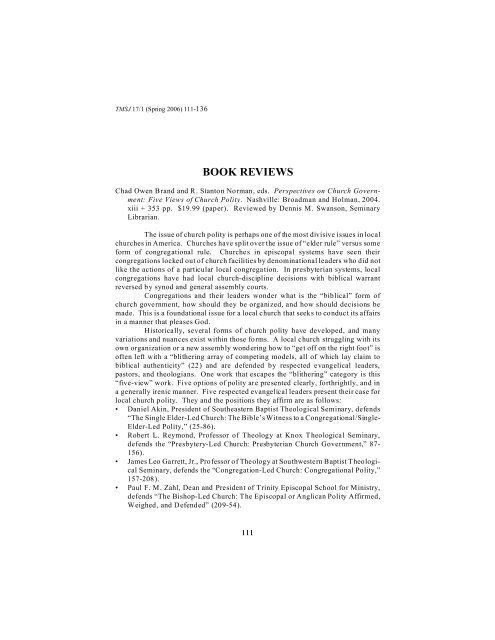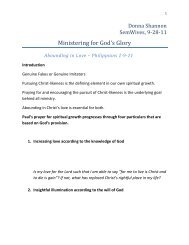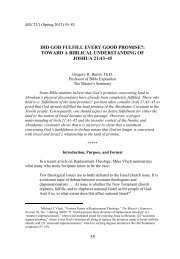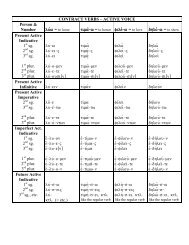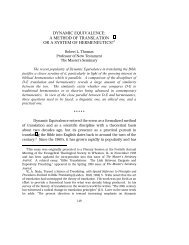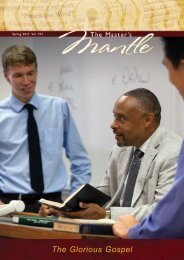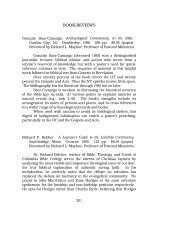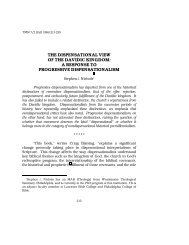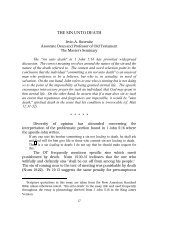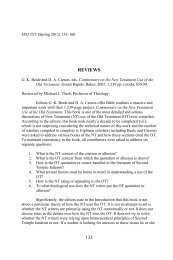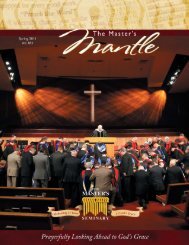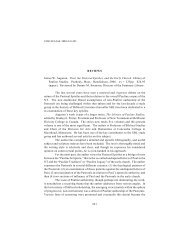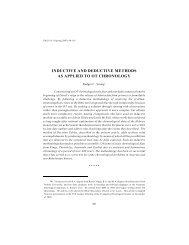Book Reviews for 17:1 - The Master's Seminary
Book Reviews for 17:1 - The Master's Seminary
Book Reviews for 17:1 - The Master's Seminary
- No tags were found...
You also want an ePaper? Increase the reach of your titles
YUMPU automatically turns print PDFs into web optimized ePapers that Google loves.
TMSJ <strong>17</strong>/1 (Spring 2006) 111-136BOOK REVIEWSChad Owen Brand and R. Stanton Norman, eds. Perspectives on Church Government:Five Views of Church Polity. Nashville: Broadman and Holman, 2004.xiii + 353 pp. $19.99 (paper). Reviewed by Dennis M. Swanson, <strong>Seminary</strong>Librarian.<strong>The</strong> issue of church polity is perhaps one of the most divisive issues in localchurches in America. Churches have split over the issue of “elder rule” versus some<strong>for</strong>m of congregational rule. Churches in episcopal systems have seen theircongregations locked out of church facilities by denominational leaders who did notlike the actions of a particular local congregation. In presbyterian systems, localcongregations have had local church-discipline decisions with biblical warrantreversed by synod and general assembly courts.Congregations and their leaders wonder what is the “biblical” <strong>for</strong>m ofchurch government, how should they be organized, and how should decisions bemade. This is a foundational issue <strong>for</strong> a local church that seeks to conduct its affairsin a manner that pleases God.Historically, several <strong>for</strong>ms of church polity have developed, and manyvariations and nuances exist within those <strong>for</strong>ms. A local church struggling with itsown organization or a new assembly wondering how to “get off on the right foot” isoften left with a “blithering array of competing models, all of which lay claim tobiblical authenticity” (22) and are defended by respected evangelical leaders,pastors, and theologians. One work that escapes the “blithering” category is this“five-view” work. Five options of polity are presented clearly, <strong>for</strong>thrightly, and ina generally irenic manner. Five respected evangelical leaders present their case <strong>for</strong>local church polity. <strong>The</strong>y and the positions they affirm are as follows:• Daniel Akin, President of Southeastern Baptist <strong>The</strong>ological <strong>Seminary</strong>, defends“<strong>The</strong> Single Elder-Led Church: <strong>The</strong> Bible’s Witness to a Congregational/Single-Elder-Led Polity,” (25-86).• Robert L. Reymond, Professor of <strong>The</strong>ology at Knox <strong>The</strong>ological <strong>Seminary</strong>,defends the “Presbytery-Led Church: Presbyterian Church Government,” 87-156).• James Leo Garrett, Jr., Professor of <strong>The</strong>ology at Southwestern Baptist <strong>The</strong>ological<strong>Seminary</strong>, defends the “Congregation-Led Church: Congregational Polity,”157-208).• Paul F. M. Zahl, Dean and President of Trinity Episcopal School <strong>for</strong> Ministry,defends “<strong>The</strong> Bishop-Led Church: <strong>The</strong> Episcopal or Anglican Polity Affirmed,Weighed, and Defended” (209-54).111
112 <strong>The</strong> Master’s <strong>Seminary</strong> Journal• James R. White, Director of Alpha and Omega Ministries, defends the “PluralElder-Led Church: Sufficient as Established— <strong>The</strong> Plurality of Elders as Christ’sOrdained Means of Church Governance” (255-96).As normal in such a view book, responses by the other contributors appearat the end of each major presentation. <strong>The</strong> work includes useful indexes (name,subject, and Scripture) and a clear introductory chapter by the editors dealing withkey issues and a brief survey of the history of church polity.<strong>The</strong> contributors uni<strong>for</strong>mly present clear definitions, biblical defenses, andgenerally offer detailed research. <strong>The</strong> publisher opted to use endnotes instead offootnotes, which often interrupts important points that the contributors were making.Each author supports his position from Scripture and with a wide array of material.For instance, Garrett has 318 notations which cover 19 pages of material.Akin’s contribution is superior to the others. He is current in hisscholarship, and while though making an affirmative case <strong>for</strong> his position, stillacknowledging room <strong>for</strong> flexibility (73). Reymond details Presbyterianism anddefends it, in large part, as a means of maintaining church and ministry “balance.”He states, “[I]t provides the most trustworthy, just, and peaceful way <strong>for</strong> the churchto determine its principles, its practices, and its priorities and to resolve itsdifferences” (135). Reymond’s point that a congregational model has “too manyministers and too many churches that are accountable to no one” (ibid.) is wellstated; however, he weakens his position considerably by attributing the tragedy ofJonestown and the scandals of Jim Bakker, Jimmy Swaggart and Jesse Jacksondirectly to a congregational model (136). In doing this, he likewise fails to note thatPresbyterianism, as a system, was not able to deal with the liberalism that eventuallyled to the reorganization of Princeton <strong>Seminary</strong> in 1929 and the wholesale departurefrom orthodoxy of several Presbyterian denominations.Thoroughly noted and detailed, the article by Garrett is more of a laundrylist of quotations and people who have supported some <strong>for</strong>m of congregationalism.His criticism of “mega-churches,” the ministry of John MacArthur, and Dallas<strong>The</strong>ological <strong>Seminary</strong>, as part of the “crisis” or “major erosion or overt rejection ofcongregational polity” (190) is a tired old canard. However, his point that individualmembers need to be more active in the affairs and ministries of their churches (192)is worthwhile.In presenting the Episcopal model, Zahl centers on the Anglican Church,which is not a major <strong>for</strong>ce in American evangelicalism. His presentation is clear andperhaps one of the best affirmative presentations of that system this reviewer hasencountered. However, it would have been helpful had he expanded his horizons toinclude the Methodist, Lutheran, and perhaps even the Roman Catholic schemas.<strong>The</strong> final presentation by James White on the plurality of elders is perhapsthe most disappointing in terms of presentation. His argument is often pedantic andhas an air of “my way or the highway” to it. He utilizes Sola Scriptura in such amanner that he makes it clear that a rejection of his position on polity is a de factomoving away from or rejection of the Sola as well. His notations are weak (he usesonly 11 footnotes), and he offers little affirmative support. In fact, his is the onlyarticle that fails to cite or quote any supporting source outside Scripture.Other points of disagreement and issues could be mentioned, but <strong>for</strong> themost part, the individual authors dispatch these in their responses to one another. A
<strong>Book</strong> <strong>Reviews</strong> 113couple of issues deserve mention, however. In assessing the Congregational model,Akin appears to correct Garrett’s assertion that John MacArthur is Presbyterian(196), but points to a reference that he identifies as “Note 99,” which has no bearingon that point. In fact, in the section discussing MacArthur (whose ministry Garrettviews as a major reason Baptist churches have moved toward “elder rule,” [191]),Garrett makes no claim that MacArthur is a Presbyterian.This book, though covering a large swath of evangelical church polity, isnot complete. It has no discussion of a minimalist polity such as in PlymouthBrethren assemblies, and as already mentioned, no discussion of the non-Anglicansystems that practice the Episcopal model. Further, it has no discussion of inherentweaknesses in each system and how, on a practical level, those are overcome. Also,it has no discussion of how one might practically implement one system or the otherif starting from scratch, how one might move a congregation from one model toanother, or under what circumstances such a change might be a good or bad idea.This is an important work and a valuable contribution to the literature ofpolity and is recommended highly. That being said, this reviewer agrees with thegreat Anglican expositor and theologian, Bishop J. C. Ryle, who stated, “<strong>The</strong>re is nota text in the Bible which expressly commands churches to have one special <strong>for</strong>m ofgovernment, and expressly <strong>for</strong>bids any other” (Ryle, Knots Untied [reprint; Moscow,Idaho: Charles Nolan, 2000] 234). <strong>The</strong> diversity of polity within local churches thatGod has chosen to bless in history make it clear that outside biblical commands thateverything should be done “properly and in an orderly fashion” (1 Cor 14:40), thatgodly men be given the task of local church leadership (1 Tim 3:1-13; Titus 1:6-9),and that those leaders must dispatch their duties with humility be<strong>for</strong>e God (1 Pet 5:2-3), the structures of church polity may vary to meet the needs of a local assembly.A. Andrew Das. Paul and the Jews. Library of Pauline Studies. Peabody, Mass.:Hendrickson, 2003. xvi + 238 pp. $24.95 (cloth). Reviewed by Paul R.Thorsell, Associate Professor of Bible, <strong>The</strong> Master’s College.Paul and the Jews continues Andrew Das’ critique of and alternative to the“new perspective” on Paul, begun in his Paul, the Law, and the Covenant. <strong>The</strong><strong>for</strong>mer volume focused on Paul’s view of the Mosaic Law and its relation to Israel’scovenant. <strong>The</strong> “new perspective,” while of heuristic value <strong>for</strong> Pauline scholarship,misconstrued Paul’s polemic against the Law as focused one-sidedly on the ethnicparticularities of torah observance. This second volume addresses Israel’scontinuing role in God’s purposes according to the apostle from Das’ “newerperspective.”Das treats Paul’s discussion of the Jews and the Law in Galatians in hissecond chapter. He cogently argues that Paul addressed Gentile Christians (“you”)who were being influenced by Jewish Christians (“they”) to be circumcised andfollow the whole of the Mosaic Law. Paul’s apocalyptic worldview in<strong>for</strong>ms hisconclusion that the arrival of Christ and the Spirit has brought the era of the Law toa close. Das suggests the intriguing thesis that Paul distinguished two Abrahamiccovenants in Galatians 4—one connected with the Law and one with the Spirit. Far
114 <strong>The</strong> Master’s <strong>Seminary</strong> Journalmore probable, in this reviewer’s estimation, the two covenants in Galatians 4 are thenew covenant and the Mosaic covenant. Paul identified Isaac (= Christians) born bythe Spirit (under the new covenant) as the true heir of Abraham rather than Ishmael(= Jews) born of the flesh (under the Law).Chapters four and five address Israel’s role in God’s plan, focusingparticularly on Romans 9–11. He connects Paul’s notion of election closely withGod’s choice of Israel. In chapter four, three solutions to the question of Israel’splace in God’s purpose are proposed and rejected. Das masterfully dismantlesKrister Stendahl’s thesis that two covenants are in view—one saves Jews and theother Gentiles. Likewise rejected are the solutions that “Israel” in Romans 11 is theelect of all ages or the Jewish remnant of all ages. Chapter five comprises Das’ ownsolution. Eschatological salvation is never apart from Christ (contra Stendahl), noris it apart from Israel’s mediation (contra replacement theology): “God’s eschatologicalplan revolves entirely around Israel” (110). Gentiles are blessed with Israel andare united with Israel without the categories of Jew and Gentile losing significance.Das’ book, Paul and the Jews, interacts with materials in which the “newperspective” is argued, but arrives at a different conclusion. “New perspective”interpreters will need to interact with Das’ proposed construction of Paulinetheology; “old perspective” interpreters will need to examine whether Das’ thesis haselements they can embrace. Despite the recent proliferation of works on Paul’s viewof the Law and Israel, Das’ contribution will remain substantial and noteworthy <strong>for</strong>some years.Walter A. Elwell and Robert W. Yarbrough. Encountering the New Testament: AHistorical and <strong>The</strong>ological Survey. 2d Edition. Grand Rapids: Baker, 2005.446 pp. $44.99 (cloth). Reviewed by Keith Essex, Assistant Professor of BibleExposition.After only seven years of the volume’s use, Walter Elwell and Robert Yarboroughhave updated their basic-level undergraduate NT survey, Encountering theNew Testament [see TMSJ 10 (1999):291-93]. <strong>The</strong> authors state that in this secondedition of their text, they have sought “to correct vague wording, update bibliography,rewrite outdated sections, and add material where the previous edition wasculpably brief” (11). However, no thoroughgoing revamping has occurred becausethe earlier work seems to have been generally effective in classroom use. <strong>The</strong>re<strong>for</strong>e,the second edition follows the same pattern as the previous work.<strong>The</strong> text continues with the same divisions as the first edition. After anintroductory chapter on “Why Study the New Testament?” (19-35) come four parts:“Encountering Jesus and the Gospels” (37-190), “Encountering Acts and the EarliestChurch” (191-250), “Encountering Paul and His Epistles” (251-344), and“Encountering the General Epistles and the Apocalypse” (345-85). An epilogueconcludes the main text, and is now entitled “Matters to Ponder” (387-94). Anextremely valuable glossary of key terms in NT study is still included (395-406).<strong>The</strong> main content of each chapter is again supplemented by sidebars that containprimary sources, quotes, and contemporary concerns, and focus boxes that present
<strong>Book</strong> <strong>Reviews</strong> 115practical application of the chapter’s material. For those who have a marked copyof the first edition and/or use it in teaching, an added benefit of this second editionis that it follows with only slight alterations in the pagination of the original edition.In keeping with the authors’ purpose, the second edition has only a fewvariations. <strong>The</strong> majority of the added material in the main text is found in thefollowing new sections: “So Many Translations” (30), critical issues in each chapterconcerning a Gospel (84, 95-96, 105, 114-15), “<strong>The</strong>mes in Acts” (211), and“General Epistle Summary” (373). A new sidebar, “Corruption in the Church”(230), is a further addition. A great amount of the rewriting is found in the focusboxes; twelve of the twenty-five have been changed in the second edition (30, 84,132, 187, 203, 219, 246, 269, 322, 340, 370, 393). <strong>The</strong> bibliographies have alsobeen updated and a few new footnotes have been added to reflect works not availablein 1998 when the first edition appeared. In the main text, the authors nowrecommend P. Stuhlmacher’s Revisiting Paul’s Doctrine of Justification as aresponse to the “new perspective” on Paul instead of T. Schreiner’s <strong>The</strong> Law and ItsFulfillment (261), although Schreiner’s work is still recommended in the bibliography<strong>for</strong> further reading on Paul (271). <strong>The</strong> visual content has not been significantlyrevised. <strong>The</strong> chapter summaries and review questions remain unchanged from theoriginal work.Because this second edition is basically the same as the original, thejudgments passed on the original review remain. <strong>The</strong> textbook continues to bepedagogically sound, visually oriented, with a good introduction to the historicalbackground of the NT and a satisfactory discussion of the purpose, structure, andmajor themes of each NT book. However, three weaknesses are still present. First,the authors view the church in continuity with the OT people of God; <strong>for</strong> them, thechurch is the new Israel (21, 203, 266). Second, the book is weak in warning thebeginning student concerning the dangers associated with critical methods used inNT study. Third, the presentation is a little on the “lite” side when compared to theNT surveys of Gundry [see TMSJ 15 (2004):120-21], Lea and Black [see TMSJ 15(2004):123], and Tenney. But it seems that this second edition of Encountering theNew Testament will continue to find a prominent place in the undergraduate studyof the NT, so teachers and pastors must be aware of its content and impact.Graeme Goldsworthy. According to Plan: <strong>The</strong> Unfolding Revelation of God in theBible. Downers Grove, Ill.: InterVarsity, 2002. 251 pp. $22.00 (paper).Reviewed by Keith Essex, Assistant Professor of Bible Exposition.<strong>The</strong> majority of American evangelicals were first introduced to GraemeGoldsworthy, <strong>for</strong>mer lecturer in Old Testament, biblical theology, and hermeneuticsat Moore <strong>The</strong>ological College, Sydney, Australia, through his book, Preaching theWhole Bible as Christian Scripture (Eerdmans, 2000). <strong>The</strong> volume had a greatimpact, including being named book of the year <strong>for</strong> 2000 by Preaching magazine.In the words of its author, the book aimed “to provide a handbook <strong>for</strong> preachers thatwill help them apply a consistently Christ-centered approach to their sermons” (ix).Goldsworthy bemoaned the fact that very little was said about biblical theology in
116 <strong>The</strong> Master’s <strong>Seminary</strong> Journalbooks on expository preaching. For him, biblical theology was one implication ofthe evangelical view of the Bible, and he believed that seeing the big picture ofScripture was necessary <strong>for</strong> effective biblical preaching. He wrote, “To theevangelical preacher, then, I would address one simple but pointed question, . . .How does this passage of Scripture, and consequently my sermon, testify to Christ?”(29). <strong>The</strong> answer was <strong>for</strong> the preacher to know salvation history as the context <strong>for</strong>the biblical text at hand. <strong>The</strong> context of salvation history is found through the studyof biblical theology. <strong>The</strong> latter half of the book gave the practical application ofbiblical theology to preaching (133-256). However, the foundation of effectiveexpository preaching was not only the preacher’s knowledge of biblical theology, butalso his hearers’ understanding of the same. Thus, Goldsworthy encouragedexpositors to train their congregants in biblical theology as he had done, using acourse of study that had subsequently been published in 1991 in Australia and GreatBritain as the book, According to Plan: <strong>The</strong> Unfolding Revelation of God in theBible (132). Because of the impact of Preaching the Whole Bible as ChristianScripture among American evangelicals, the earlier work, According to Plan, hasbeen published <strong>for</strong> the American market.Goldsworthy introduces According to Plan as “a biblical theology <strong>for</strong>ordinary Christians” (7). <strong>The</strong> work is a beginner’s guide, and the author has kept theterminology simple, with many charts, summaries at the beginning of each chapter,and study guide questions at the conclusion of each chapter. <strong>The</strong> book divides intofour parts. Part One asks why Christians should be concerned with biblical theology(15-25). <strong>The</strong> writer introduces some of the practical situations and problems inunderstanding and applying the Bible that are answered by relating them to the onemessage of the Scripture which is the concern of biblical theology. Part Two is adiscussion of how biblical theology is done (27-78). <strong>The</strong> author shows how God hasmade Himself known through Christ and Scripture. <strong>The</strong> proper presuppositions (seelist on 45) and methods of interpretation one uses in approaching the Bible as God’srevelation are special concerns addressed in these pages. Part Three is the heart ofthe book where the what, the content, of biblical theology is described (79-234).Here, Goldsworthy spells out what <strong>for</strong> him is the major theme of the Bible, thegospel of Jesus Christ, and the other significant themes associated with it. <strong>The</strong>sethemes are developed progressively as they are in Scripture from creation to theconsummation in the eternal state. Part Four is a short introduction to where thecontent and method of biblical theology can be applied (235-44). <strong>The</strong> subjects ofknowing God’s will and life after death are used as examples of how study of theBible can be enhanced once the big picture of Scripture has been grasped. <strong>The</strong> bookconcludes with a subject index (345-46) and a Scripture index (247-51).Goldsworthy’s presentation has a number of noteworthy features. First, theimportance of and presentation to the ordinary Christian of basic biblical truth mustbe emphasized. <strong>The</strong> volume is a model of how to educate the beginner in goodtheology in a simple way without ‘dumbing down’ the content. Second, the writer’scommitment to the authority of Scripture and the reader’s need to receive it by faithas God’s Word are well stated. Third, the centrality of the gospel to proper biblicalunderstanding and a firm statement of the subject matter of the gospel can beaffirmed as foundational <strong>for</strong> the Christian. Fourth, the reminder of the Christocentricnature of the scriptural revelation is helpful. Finally, the challenge of
<strong>Book</strong> <strong>Reviews</strong> 1<strong>17</strong>isolating the major themes and their development throughout the Bible is a neededemphasis. <strong>The</strong> author’s simple, yet profound, statement of his understanding of thecontent of biblical theology will be helpful to all Christian believers, even those whomay disagree with him at points.Nevertheless, some statements made by Goldsworthy need to be questioned.First, as to the basic method employed in biblical study, the writer states, “In doingbiblical theology as Christians, we do not start at Genesis 1 and work our way<strong>for</strong>ward until we discover where it is all leading. Rather we first come to Christ, andhe directs us to study the Old Testament in the light of the gospel” (55). <strong>The</strong> grid ofbiblical understanding, <strong>for</strong> this author, is developed from the NT and the OT is thenread through this grid. Second, a result of this type of reading of the OT is a denialof literalism in the interpretation of OT prophecies (67-69). This is affirmed becauseJesus and the NT writers understood the OT prophecies through the principle of“typology.” Although such terms as land, exodus, and temple have specificcorrespondence to literal realities in the OT, they are seen in the NT as fulfilled inJesus Christ, not literally, but typically. In the words of the author, “Literalisminvolves the very serious error of not listening to what the New Testament says aboutfulfillment. It assumes that the fulfillment must correspond exactly to the <strong>for</strong>m of thepromise” (67). In contrast to Goldsworthy, the present reviewer would affirm thatbiblical theology should proceed from Genesis 1 and OT prophecies should beunderstood literally. <strong>The</strong> resulting content of biblical theology will be premillennialin orientation instead of the amillennial approach that Goldsworthy states. Much inthe areas of God’s authority, man’s rebellion, God’s redemption of believing sinners,and the blessings of union with Christ is profitable. Yet along with the agreement,the fundamental difference as to the present spiritual inauguration of kingdom andits consummation in the new Jerusalem being the totality of biblical fulfillment ofOT prophecies is inevitable.Along with Goldsworthy, the affirmation that both expositors and hearersshould have a big-picture understanding of the Bible can be made. However, <strong>for</strong> thisreviewer, <strong>The</strong> Greatness of the Kingdom by Alva J. McClain, which begins atGenesis 1 and works <strong>for</strong>ward and takes the OT prophecies literally, is a betterstarting point <strong>for</strong> both expositors and congregants than According to Plan.Justo L. Gonzalez. Essential <strong>The</strong>ological Terms. Louisville: Westminster/JohnKnox, 2005. xii +187 pp. $24.95 (paper); and Henry W. Holloman. KregelDictionary of the Bible and <strong>The</strong>ology. Grand Rapids: Kregel, 2005). 600 pp.$21.77 (cloth). Reviewed by Dennis M. Swanson , <strong>Seminary</strong> Librarian.In the ever-changing theological landscape, new terms are appearing (anddisappearing) at a faster rate than at any time in history. At the same time even termsthat seem to be established in the evangelical mind are being altered, either bywholesale or by slight nuance. It is important that the pastor’s library have solidreference works to help him understand accurately the meaning of theological terms.In Essential <strong>The</strong>ological Terms, the author, a long time professor andprolific writer in church history, has undertaken to provide definitional clarity to
118 <strong>The</strong> Master’s <strong>Seminary</strong> Journalabout 300 theological terms and phrases. He acknowledges that “theologicallanguage evolves” (xi) and understands that this work will eventually become dated,but hopes that the book will provide “the essential theological vocabulary necessary<strong>for</strong> a budding theologian to be in dialogue with the theology of centuries past” (xii).In this task the author has largely succeeded.<strong>The</strong> work is laid out in a normal dictionary <strong>for</strong>mat with a listing of articletitles and page numbers in the front. However, it includes no other indexes, whichwould have been of help to the reader. <strong>The</strong> articles are generally detailed (somenearly a full page in length) and reflect the author’s refreshingly clear writing style.<strong>The</strong> strength of the work is the underlying expertise of the author in historicaltheology. That the same publisher produced the Westminster Dictionary of<strong>The</strong>ological Terms (by Donald K. McKim) only a few years ago is interesting. Thatwork and this one deal with the same type of material (the cover motif <strong>for</strong> both issimilar), and this reviewer could find no entries by Gonzalez that were not also in theearlier work. <strong>The</strong> articles in this work are often more detailed than McKim, but ithas about 200 fewer entries.Gonzalez is neither conservative in his theology nor seemingly friendly toevangelical theology. His entry on “Fundamentalism” (66), though giving the basicsof its origination, makes a link between Christian fundamentalism and Islamicfundamentalism, an egregious misrepresentation of Christian or biblical fundamentalism.<strong>The</strong> idea that all “fundamentalisms” are “bad” has even become popularwith some evangelical leaders. Another entry on “Dispenationalism” is equallymisguided. Gonzalez states, “[M]ost biblical scholars dismiss dispensationalism asunin<strong>for</strong>med and as a misguided interpretation of Scripture” (46). He then goes onto state that dispensationalism does enjoy “adherents among the masses” and usesthe popularity of the Left Behind novels to support his assertion about a lack ofcredibility in dispensational theology.However, despite obvious lacks, the author gives some definitional clarityto a good number of terms that have arisen in a few decades, as well as those <strong>for</strong>standard terms and movements. <strong>The</strong> entries, however, lack any bibliographicnotations, a disadvantage <strong>for</strong> the reader desiring to do more research.Though the author has produced a worthwhile book that provides a usefulreference <strong>for</strong> students or busy pastors, the intermediate size of the articles issomewhat unsatisfying. It has neither the breadth of terms that the “ready reference”style of the work of McKim af<strong>for</strong>ds, nor does it have the depth of in<strong>for</strong>mation that,<strong>for</strong> instance, the far superior Evangelical Dictionary of <strong>The</strong>ology (Baker, 2d ed.,2001) offers. <strong>The</strong> high price of this book is also somewhat unappealing given itsrelative brevity.Although slightly different in focus and scope, the second book of thisreview, the Kregel Dictionary of the Bible and <strong>The</strong>ology, is a superior investment.Holloman, longtime professor of systematic theology at the Talbot Schoolof <strong>The</strong>ology has produced an excellent dictionary of “over 500 key theologicalwords and concepts” (subtitle) that is unique in the recent reference literature. <strong>The</strong>articles are generally quite detailed with several being over two pages in length.Many but not all have an introductory bibliography. <strong>The</strong> beginning of the work hasa set of abbreviations, which is more important than normal as the author acknowledgesthat they are not the “designations normal to biblical scholarship” (5). <strong>The</strong>
<strong>Book</strong> <strong>Reviews</strong> 119articles themselves have the useful feature of offering the biblical terms in separatesections at the end of the articles. <strong>The</strong> Hebrew and Greek words are given alongwith transliterations and the word meanings are detailed. All the articles haveextensive biblical references.One might question the title of the book in relation to the content. Thoughcalled a Dictionary of the Bible and <strong>The</strong>ology, it is probably more accurately adictionary of “Biblical <strong>The</strong>ology.” It has no articles on traditional theological termssuch as “Calvinism,” rather the entry points are the biblical terms (e.g., “Election,”“Justification,” and “Predestination”) related to those positions. Little attention isgiven to historical development of the terms, and allusions to historical theology areoften simply illustrative (e.g., “Deism,” <strong>17</strong>8). This is not to say the work ignorescurrent issues in theology; however, they are developed from within the frameworkof the biblical terminology (e.g., the issues related to “Open <strong>The</strong>ism” are developedwithin the article on “God” [<strong>17</strong>1-78]; the issues related the Christological controversiesare examined within the article on “Incarnation” [230-34]; the classic definitionof “creationism” as it relates to the origin of the soul occur within the article on“Soul, Spirit” [509-13, one of this work’s excellent articles]; issues related to thecreation of the earth and universes is dealt with under “Creation” [88-93]).Publishers’ space limitations are understandable, but this book would have beengreatly enhanced with a subject index, and in light of the massive amount of biblicalreferences contained in the articles, a Scripture index would have been of inestimablevalue.Within the articles, Holloman is thoroughly even-handed in presenting thediffering interpretations (e.g., millennial and rapture views, classic vs. progressivedispenationalism) and practices (e.g., baptism and communion). <strong>The</strong> articles areclear and engaging, and have a generous use of “see also” references to point thereader to additional in<strong>for</strong>mation.This is one of the best reference works of its kind to be produced in manyyears. It is a thoroughly refreshing biblical exposition of theological concepts thatreflects the author’s breadth and depth of study. It deserves a place at the right handof every pastor and student of the Bible as a significant and major contribution to thereference literature <strong>for</strong> biblical studies. It cannot be recommended highly enough.Wayne Grudem. Evangelical Feminism & Biblical Truth. Sisters, Ore: Multnomah,2004. 858 pp. $29.00 (paper). Reviewed by Richard L. Mayhue, SeniorVice-President and Dean, Professor of Pastoral Ministry and <strong>The</strong>ology.Dr. Grudem first gained worldwide visibility on this subject matter with thepublication of Recovering Biblical Manhood and Womanhood (Wheaton, Ill:Crossway, 1991), co-edited with John Piper (see my review in TMSJ 2/1 [Spring1991]:108–10). This latest work, written exclusively by Grudem, finished as afinalist in the <strong>The</strong>ology/Doctrine category <strong>for</strong> the 2005 Gold Medallion <strong>Book</strong>Awards given by the Evangelical Christian Publishers Association.EFBT represents over a decade of Dr. Grudem’s updated research andongoing dialogue with those who take issue over the “complementarian” understand-
120 <strong>The</strong> Master’s <strong>Seminary</strong> Journaling of male/female roles in the home and church. An extensive bibliography (booksand articles), eight appendixes (especially studies of kefalhv and aujqentevw), andthree indexes (Scripture, name, and subject) make this volume exceptional in itsusability and value. Though the contents reflect Grudem’s commendable scholarlyresearch and clear thinking, he also presents the material in an extraordinarily wellorganized<strong>for</strong>mat and highly readable prose.<strong>The</strong> heart of the volume resides in chapters 3-12, which thoroughly answer118 arguments that evangelical feminists have rendered over the years in denial of“completarianism” and in favor of “egalitarianism.” Grudem proves masterful in hisrefutation of the arguments. Yet, he maintains an unusually irenic and charitablespirit in so doing, <strong>for</strong> which he is to be commended in light of the volatilityassociated with many materials written on this topic. Grudem unquestionablydeserves to be categorized as “comprehensive and fair.”Chapters 1-2 contain a positive view of men and women in their similaritiesand differences as created by God. <strong>The</strong> biblical truths of equality in value (bothmale and female created in the image of God) and variety in home and church roles(as revealed by the Creator in Scripture) receive a balanced treatment. Chapters 13-14 question evangelical feminists’ real allegiance to the full authority of Scriptureand project the unorthodox results if they do not.EFBT should be read by anyone who wants to understand both Scriptureand the current debate on this theme. I highly recommend this new volume by Dr.Grudem as the appropriate follow-up to and extension of the discussion in the earliervolume, Recovering Biblical Manhood and Womanhood.John D. Hannah, Charts of Modern and Postmodern Church History. GrandRapids: Zondervan, 2004. 160 pp. $29.99 (paper). Reviewed by Larry D.Pettegrew, Professor of <strong>The</strong>ology.As the author remarks in the introduction to this series of charts, “<strong>The</strong> valueof history has fallen on difficult times in contemporary culture. Postmoderns havedemonstrated a tendency to disregard the past as a useless and even debilitating relic,something akin to unwanted dreams and painful experiences” (11). This book isdedicated to helping correct this regrettable situation, even in evangelical churches.<strong>The</strong> author is department chairman and distinguished professor of historicaltheology at Dallas <strong>The</strong>ological <strong>Seminary</strong>. <strong>The</strong> book is actually book three in athree-part series on church history—the previous two dealing with ancient andmedieval church history, and the Re<strong>for</strong>mation and Enlightenment church history.This series of charts is divided into three sections: <strong>The</strong> National Period ofAmerican Church History; <strong>The</strong> Modern Period of American Church History; and<strong>The</strong> Postmodern Period of Church History. <strong>The</strong>re are a total of 133 charts,diagrams, maps, and explanatory captions. <strong>The</strong> book includes, <strong>for</strong> example, suchcharts as “Developments Within Nineteenth-Century American <strong>The</strong>ology”; “<strong>The</strong>Birth of Modern Missions Movement”; “<strong>The</strong> <strong>The</strong>ology of Jehovah’s Witnesses”;“<strong>The</strong> History of American Evangelicalism”; “Liberal <strong>The</strong>ology and Evangelical<strong>The</strong>ology: A Comparison”; “<strong>The</strong> History of the Charismatic Movements in
<strong>Book</strong> <strong>Reviews</strong> 121America”; “<strong>The</strong> Church Growth Movement”; and “Postmodernism and Authority.”Included with the book is a CD-ROM PowerPoint presentation that makesthe charts all the more valuable. <strong>The</strong> teacher is thus enabled to use the book to seethe charts at an easy glance, and then choose the particular charts that will help hisPowerPoint presentation.<strong>The</strong> book is highly recommended as an excellent way to help teachers inSunday School classes, Bible institutes, colleges, and seminaries communicate moreprecisely the facts and insights of church history.Martin Hengel. <strong>The</strong> Septuagint as Christian Scripture: Its Prehistory and theProblem of Its Canon. Trans. Mark E. Biddle. Grand Rapids: Baker, 2002. xvi+ 153 pp. $24.99 (paper). Reviewed by William D. Barrick, Professor of OldTestament.LXX and patristics scholars will find this volume a stimulating read. MartinHengel is emeritus professor of NT and ancient Judaism at the University ofTübingen, Germany. He is the author of over fifty published books including <strong>The</strong>‘Hellenization’ of Judea in the First Century After Christ (reprinted; Wipf & Stock,2003), <strong>The</strong> Four Gospels and the One Gospel of Jesus Christ: An Investigation ofthe Collection and Origin of the Canonical Gospels (Trinity Press International,2000), and Between Jesus and Paul: Studies in the Earliest History of Christianity(reprinted; Wipf & Stock, 2003). Robert Hanhart, the third director (1961-1993) ofthe Septuaginta-Unternehmen in Göttingen, contributed the “Introduction” <strong>for</strong> thisvolume (1-<strong>17</strong>). A collection of indexes closes the volume (129-53).Canonicity is the primary focus of the essays in <strong>The</strong> Septuagint as ChristianScripture. Hengel originally presented his essays to an ecumenical group ofProtestant and Catholic theologians working on the interconfessional differenceswith regard to the development of the OT canon. Scholars identify the twodeveloping Old Testaments as the Palestinian (following the Masoretic tradition) andthe Alexandrian. Protestant churches adhere to the <strong>for</strong>mer while the Roman CatholicChurch has followed the latter with its inclusion of apocryphal or deuterocanonicalbooks. Hanhart believes that the Palestinian canon had already been establishedbe<strong>for</strong>e being translated into Greek (4-5). He observes that the early Christiancommunity was concerned about the canonicity of LXX portions that were indisagreement with or absent in the Hebrew original (6, 10). Both the Christian andthe Jewish communities diverge in their treatment of the Tetragrammaton () intheir respective LXX manuscripts. Jewish LXX manuscripts transmit the Tetragrammatonitself rather than the Greek translation kuvrio" followed in LXX manuscriptsof Christian origin (7). Hanhart concludes that the Jewish employment of <strong>for</strong>the Tetragrammaton preceded the Christian adoption of kuvrio" (8).Both Hanhart and Hengel agree that the Christian community defendeddifferences between the Greek and Hebrew texts by claiming divine inspiration <strong>for</strong>the Greek translation (11, 52-53). Though Hanhart appears to assume the existenceof a full Palestinian canon of the OT in the pre-LXX community, Hengel argues thatsome of the books attributed to the Palestinian canon only became part of it
122 <strong>The</strong> Master’s <strong>Seminary</strong> Journalfollowing the Alexandrian canon’s development. Hengel first examines the Letter ofAristeas and the accretion of legends around the translation of the LXX (25-41).Next, he establishes the existence of a Christian LXX (41-56). One of the pieces ofevidence that he presents <strong>for</strong> a distinction between Jewish and Christian LXXs is useof the codex <strong>for</strong> Christian documents as compared to the scroll <strong>for</strong> Jewish (41).Hengel’s second major essay (“<strong>The</strong> Later Consolidation of the Christian‘Septuagint Canon,’” 57-74) examines the absence of a fixed order of the canonicalbooks of the OT. He argues that the debate over the apocrypha in the Re<strong>for</strong>mationoccurred because the dispute had not been resolved in the early church (66).Disputed books included Esther, Canticles, Qoheleth (Ecclesiastes), and Daniel.Un<strong>for</strong>tunately, Hengel himself raises questions about these books. In his opinion,Canticles is probably a “profane love poem” (92), Qoheleth is “semi-cloaked undera pseudonym” (93), and Daniel was written around 165 B.C. (95; obviously, afterthe fulfillment of its prophecies in chap. 11). For this reason, the evangelical readerwill find Hengel’s seemingly cavalier treatment of Scripture frustrating anddisappointing.Next, Hengel examines the origin and development of the Jewish LXX (75-103). He observes that LXX texts at Qumran demonstrate the existence of a JewishLXX, since the Essenes were characteristically antagonistic to all influences fromHellenistic culture (82). For this reviewer, one of Hengel’s most fascinatingsuggestions is that the apostle Paul may have produced his own Greek translation ofthe OT <strong>for</strong> some of his citations from Isaiah, Job, and 1 Kings (83, 89).<strong>The</strong> final essay deals with the origin of the Christian LXX and its additions(105-27). In it he reveals that he accepts a late date around A.D. 130 <strong>for</strong> Peter’ssecond epistle in the NT (108). He also concludes that the “question of why the OldTestament attained in the church precisely the <strong>for</strong>m present—still not completelyuni<strong>for</strong>mly—in the great codices of the fourth and fifth centuries is essentiallyinsoluble” (112). As to how the canon <strong>for</strong> the Christian LXX’s books was finalized<strong>for</strong> the Christian church, Hengel hypothesizes that the cause was probably theexistence of a community archive or library in Rome with connections to Alexandria(122-23). In his final paragraphs he goads the reader by questioning the consistencyof closing the OT canon at all, if the biblical canon must remain open <strong>for</strong> the NT(125-26).Kent and Barbara Hughes. Disciplines of a Godly Family. Revised edition.Wheaton, Ill.: Crossway, 2004. 256 pp. $<strong>17</strong>.95 (cloth). Reviewed by MichaelA. Grisanti, Associate Professor of Old Testament.Kent and Barbara Hughes have effectively served the congregation ofCollege Church in Wheaton, Illinois <strong>for</strong> a number of years. As the parents of fourchildren and the grandparents of nineteen, they draw from a wealth of experience aswell as from a lifetime dedicated to the study of God’s Word. This volumeoriginally appeared with the title, Common Sense Parenting, and was published byTyndale House Publishers in 1996. Crossway’s release of this revised edition offersreaders a number of simple, practical ideas about how to rear a godly family and
<strong>Book</strong> <strong>Reviews</strong> 123have fun in the process.<strong>The</strong> chapters are categorized under three headings: Building a Family(establishing a heritage, promoting family affection, starting family traditions),Spirituality (cultivating the soul, praying with dedication, pursuing family ministry,instilling healthy self-regard [not self-esteem]), and Everyday Living (usingappropriate discipline, teaching good manners, fostering life-long enrichments).Each chapter ends with application questions. Almost 90 pages are devoted to anextensive appendix that covers a host of practical issues like aids to Christianeducation <strong>for</strong> use in the family, resources <strong>for</strong> celebrating Advent, and instructionson conducting a Christian Passover. Among other topics, it provides suggestions <strong>for</strong>making a prayer notebook, offers common-sense tips regarding discipline, suggestedreading lists <strong>for</strong> children, ideas <strong>for</strong> assembling a home movie library, selectedHughes family recipes, and answers to common questions.As with any practical book, not all suggestions offered by the Hugheses willfit a given family’s approach to parenting. Regardless, as a parent of eight children,this reviewer found encouragement in the Hughes’ commitment to rearing a godlyfamily and doing it with a joyful heart. For parents who labor under a heavy load ofministry and/or employment, a warm exhortation to devote themselves to this Godgiventask, as well as the provision of a number of enlightening suggestions, makesthis book a potential blessing. For those in the ministry, devotion to the accurate andrelevant preaching of God’s Word cannot replace consistent parental involvementin the lives of their children. As the Hughes point out, “the truth is, a pound ofparent is worth a hundred pounds of preaching” (62).Carter Lindberg, ed. <strong>The</strong> Pietist <strong>The</strong>ologians: An Introduction to <strong>The</strong>ology in theSeventeenth and Eighteenth Centuries. Ox<strong>for</strong>d: Blackwell, 2005. xvi + 282 pp.$39.95 (cloth). Reviewed by Paul R. Thorsell, Associate Professor of Bible, <strong>The</strong>Master’s College.Carter Lindberg’s <strong>The</strong> Pietist <strong>The</strong>ologians stands as the next volume inBlackwell’s series surveying the major theologians of the Christian church. <strong>The</strong>seventeenth and eighteenth centuries are the focus of the current volume. Sixteenchapters by as many authors introduce the reader to the lives and thoughts of selected“pietist theologians” of those centuries.But who are these “pietist theologians”? <strong>The</strong>rein lies the book’s fundamentalambivalence. Are these the significant theologians of Pietism? Some certainlyare (Spener, Francke, Arnold, Zinzendorf, Bengel). Is there a concrete historicalmovement that can be labeled “Pietism”? In the introduction, Lindberg notes thelack of scholarly consensus on this question. Are these representative theologiansof an era that can appropriately be labeled “pietist”? If so, the omission of somesignificant theologians (Amyraut, Grotius, Quenstedt)—even some theologians withnotable contributions to individual spirituality (Edwards, Law, Owen)—isinexplicable. <strong>The</strong> inclusion of others (Gerhardt, Guyon) who can only remotely becalled “theologians” is also puzzling.Despite this ambivalence, the book contains a wealth of in<strong>for</strong>mation and
124 <strong>The</strong> Master’s <strong>Seminary</strong> Journalinsight into the variety and connection of theological thought during this era.Wallmann’s chapter delightfully details the significant influence of Johann Arndt’sTrue Christianity on European and American Lutheranism. Lovelace points out theongoing correspondence that took place in the early eighteenth century between theAmerican Puritan Cotton Mather and the German Pietist August Francke.Durnbaugh cites the influence of the quixotic Jane Leade on the Anglican WilliamLaw, continental <strong>The</strong>osophists, and Count Zinzendorf. Jung describes JohannaPetersen as a millenarian advocating a future, Jewish-centered millennium more thana century be<strong>for</strong>e John Darby’s nascent dispensationalism. Overall, Lindberg’s <strong>The</strong>Pietist <strong>The</strong>ologians fills in significant gaps in understanding the theology of theperiod.J. G. McConville. Deuteronomy. Apollos Old Testament Commentary. DownersGrove, Ill.: InterVarsity, 2002. 544 pp. $44.99 (cloth). Reviewed by MichaelA. Grisanti, Associate Professor of Old Testament.McConville is a British scholar who has distinguished himself inDeuteronomy studies. This volume is one of the first two offerings in the newApollos Old Testament Commentary. <strong>The</strong> series “takes its name from theAlexandrian Jewish Christian who was able to impart his great learning fervently andpowerfully through his teaching (Acts 18:24-25)” (9). <strong>The</strong> series hopes to work withone foot firmly planted in the universe of the original text as well as communicatethe meaning and practical application of Deuteronomy to a modern audience.In his introduction to the book, McConville proposes that the book consistslargely of Moses’ speeches (19), which are surrounded by 3rd person narration. Hesuggests that in the context of the ancient world, Deuteronomy should be seen “asa radical blueprint <strong>for</strong> the life of a people, at the same time spiritual and political,and running counter to every other social-political-religious programme” (21).Though McConville critiques the critical consensus about the composition ofDeuteronomy, he clearly affirms that his commentary “does not defend Mosaicauthorship” (39). On the one hand, he does not discount the evidence cited bynumerous conservative evangelical scholars that points to a 2nd millenniumbackground <strong>for</strong> Deuteronomy. On the other hand, he affirms that this kind ofevidence “broadly supports the relatively early date that I advocate” (40). <strong>The</strong>frustrating part is that McConville has chosen “not to try to date the book exactly”(40) and offers no precise idea what “relatively early date” he refers to.<strong>The</strong> commentary on Deuteronomy proceeds section by section through thebook. Although McConville provides no over-arching outline of the book (whichis a weakness), one can identify the major pericopes he identifies. Each pericopereceives treatment under five headings. After McConville’s own translation of thetext, he provides a section dealing with textual issues (“Notes on the Text”),sometimes relating to text criticism and others to morphology, syntax, or wordmeanings. After he deals with “Form and Structure” issues, he devotes the mostpages on that pericope to his “Comment” section, generally arranged by smallerverse units. He concludes his treatment of a pericope with an “Explanation” section
<strong>Book</strong> <strong>Reviews</strong> 125in which he summarizes the message of the verses discussed.<strong>The</strong> volume concludes with a thorough bibliography (30 pages, singlespaced) that is abreast of recent scholarship on Deuteronomy as well as a helpful setof indexes (Scripture references, authors, and subjects). <strong>The</strong>se concluding featuresadd to the value and potential impact of the volume on those interested in workingin Deuteronomy studies.<strong>The</strong> primary weakness of the volume, the absence of an analytical outline,does not erase the significance of McConville’s work. Such an outline would helpthe reader understand or recognize decisions McConville made about the flow of thebook’s message. In spite of the few concerns cited above, the commentary deservesa place on the shelf of any student who desires to understand the message ofDeuteronomy.Doug McIntosh. Deuteronomy. Holman OT Commentary. Nashville: Broadman& Holman, 2002. xiii + 386 pp. $19.99 (cloth). Reviewed by Michael A.Grisanti, Associate Professor of Old Testament.This commentary, as well as others in the same series, seeks to provide itsreaders with a user-friendly resource that will primarily help lay-people who areteaching the Bible in their local church or in individual and group Bible studies.After an introductory chapter that introduces the reader to the authorship ofDeuteronomy (accepting Mosaic authorship and a date of composition of ca. 1406B.C.), the recipients and the themes of Deuteronomy, McIntosh provides acommentary on each chapter of the book. Each chapter of the commentary has tencomponents: a stimulating quotation, a summary statement <strong>for</strong> the chapters underconsideration (“in a nutshell”), an introductory illustration to catch the attention ofthe audience, a verse-by-verse commentary (albeit brief), an overview of principlesand applications that arise from the passage at hand, life application, a suggestedprayer, a consideration of details not covered by the commentary section (“DeeperDiscoveries”), giving attention to certain key words, phrases, and themes of theBible, a teaching outline or plan, and several issues <strong>for</strong> discussion. <strong>The</strong> commentarysection has interspersed throughout helpful summary statements at each main pointas well as at the end of the chapter (“supporting idea” and “main idea review”). Aglossary of key terms and a brief bibliography conclude the volume.This reviewer has only used a handful of the volumes in this series and withmixed success. <strong>The</strong> present volume is one of the better volumes in the series. Areader who understands the limitations of space available to the author can read thiscommentary and gain a better feel <strong>for</strong> the message of Deuteronomy. For those whoare searching <strong>for</strong> illustrations, appropriate quotes, and summary principles, McIntoshoffers potential help to the preacher.One of the major disadvantages of this commentary on Deuteronomy, abook that gives primary attention to the Mosaic Law, is that it does not offer thereader any suggestions on how the Mosaic Law does or does not apply to thebeliever of today. <strong>The</strong> applicational thoughts offered by the author are generallyvalid, but would have been strengthened by giving some attention to that issue.
126 <strong>The</strong> Master’s <strong>Seminary</strong> Journal<strong>The</strong> editor of the series and the author of each volume are pursuing a verycommendable goal, i.e., providing an understandable treatment of each biblical book<strong>for</strong> lay-people.Calvin J. Roetzel. Paul: A Jew on the Margins. Louisville: Westminster/JohnKnox, 2003. xii + 116 pp. $14.95 (paper). Reviewed by Paul R. Thorsell,Associate Professor of Bible, <strong>The</strong> Master’s College.My initial—and favorable—acquaintance with Calvin Roetzel, long-timescholar of Paul, came from his monumental work, Judgement in the Community(Brill, 1972). Although written prior to the revolution in Pauline studies set off byE. P. Sanders, Roetzel’s early tome was weighty and persuasive. <strong>The</strong> presentvolume is neither. Paul: A Jew on the Margins is a collection of four previouslypublished articles. <strong>The</strong> best of the four (chap. three) reprises the oldBultmann/Käsemann discussion on Paul’s use of apocalyptic. Roetzel takes thechapter to explore Paul’s use and reworking of Jewish apocalyptic categories Allfour articles are reworked to emphasize Paul’s status as “marginal Jew.” Two newchapters are appended to these four: “Paul—A Jew on the Margins” (hence the title)and “Paul as Mother: A Metaphor <strong>for</strong> Jewish-Christian Conversion?” <strong>The</strong> firstintroductory chapter portrays Paul as living at the margins of both Judaism andChristianity; the second probes Paul’s use of feminine maternal imagery to embracethe humility of Christ. Neither is persuasive. Roetzel’s volume is, in my estimation,a sad example of what happens when socio-political rhetoric hijacks biblical studies.Mark F. Rooker. Studies in Hebrew Language, Intertextuality, and <strong>The</strong>ology. Textsand Studies in Religion 98. Lewiston, N.Y.: Edwin Mellen, 2003. xiii + 264 pp.$109.95 (cloth). Reviewed by William D. Barrick, Professor of Old Testament.Mark Rooker is professor of Old Testament and Hebrew at SoutheasternBaptist <strong>The</strong>ological <strong>Seminary</strong>, Wake Forest, N.C. His previous books includeBiblical Hebrew in Transition: <strong>The</strong> Language of the <strong>Book</strong> of Ezekiel (JSOTSup 90,Sheffield, 1990) and Leviticus (New American Commentary, Broadman & Holman,2000—see review in TMSJ 12/1 [Spring 2001]:123-24). Studies in HebrewLanguage, Intertextuality, and <strong>The</strong>ology is a collection of twelve essays by Rooker.Four essays deal with diachronic linguistics, one (the only essay not previouslypublished) with textual criticism, two with intertextuality, two with the interpretationof Gen 1:1-3, and three on the theology of the Flood, the Law, and the Conquest.Diachronic linguistics is one of Rooker’s <strong>for</strong>tes and the subject of his firstbook on the language of Ezekiel. <strong>The</strong>re<strong>for</strong>e, the reader will not be surprised that thefirst three essays deal with the same topic. “<strong>The</strong> Diachronic Study of BiblicalHebrew” (3-18) introduces the topic by sketching the history of linguistics and itsapplication to biblical Hebrew. “Ezekiel and the Typology of Biblical Hebrew” (19-44) examines Robert Polzin’s characteristics of Late Biblical Hebrew (LBH).
<strong>Book</strong> <strong>Reviews</strong> 127Rooker demonstrates that most of the characteristics in Polzin’s list are legitimate,though a few are questionable (25) due to misinterpretation of the data (27), failureto normalize text sampling length (28), and deficiencies in the use of ratios (29).Rooker concludes that Ezekiel is a better model <strong>for</strong> the transition state of Hebrewbetween Early Biblical Hebrew and LBH than the Priestly (P) document claimed bydocumentarians (44). “Diachronic Analysis and the Features of Late BiblicalHebrew” (45-57) presents four representative elements of LBH drawn fromorthography, morphology, and syntax. Rooker then utilizes these evidences of LBHto argue against the exilic or post-exilic dating of Isaiah 40–66 in one of thevolume’s most significant essays (“Dating Isaiah 40–66: What Does the LinguisticEvidence Say?” 59-73).Making its first appearance in a publication, “Old Testament TextualCriticism” (75-97) offers a conservative approach that every student of the OTshould read. Rooker defines textual criticism (75), explains its need (76-77),describes its witnesses (78-85), provides a concise history of the text (86-90), andevaluates local text theory vs. linear development (90-92). After discussing thepractice of textual criticism (93-96), he concludes that the Masoretic Text is “thebest witness to the original text” (96).“<strong>The</strong> Use of the Old Testament in the <strong>Book</strong> of Ezekiel” (101-11) and “<strong>The</strong>Use of the Old Testament in the <strong>Book</strong> of Hosea” (113-33) deal with intertextuality.For Ezekiel’s citations and allusions to prior biblical materials, Rooker examinesconnections to Leviticus 26 in Ezekiel 4–5, Zephaniah 3:1-4 in Ezekiel 22, andportions of Numbers 18 in Ezekiel 44. He concludes that Ezekiel’s exegeticalmethods (promise-fulfillment, use of OT passages as a mode or vehicle ofexpression, and typological exegesis) are basically the same as those employed byNT writers (110-11). Rooker discusses Hosea’s references to the creation, Abraham,and Jacob narratives in Genesis, as well as the exodus narratives in Exodus,Numbers, and Deuteronomy (114-22). He also handles references to Joshua, Judges,and the book of Kings (122-24). As one would expect, Hosea’s use of Deuteronomyeclipses his references to the Decalogue and other legal texts from Exodus andLeviticus (124-30). Like other Hebrew prophets, Hosea drew heavily from Leviticus26 and Deuteronomy 28 (130-31). Such usage of prior texts demonstrates anaccepted canon even in the eighth century B.C. (133).Two essays focus on Gen 1:1-3 (“Genesis 1:1-3: Creation or Recreation?Part 1,” 137-49 and “Part 2,” 151-71). In these studies Rooker carefully analyzes thegap theory (a.k.a. restitution theory), the initial chaos theory, and the precreationchaos theory. In “Part 1” he correctly rejects the gap theory on grammatical grounds(138-40) and adopts a modified initial chaos theory after careful exegetical analysis(140-49). “Part 2” presents an effective detailed response to Bruce W altke’sprecreation chaos stance (Creation and Chaos [Portland, Ore.: Western ConservativeBaptist <strong>Seminary</strong>, 1974]).“<strong>The</strong> Genesis Flood” (<strong>17</strong>3-202) defends the universality of Noah’s Flood(<strong>17</strong>8-79). While Rooker presents the basic arguments pro and con <strong>for</strong> the two mostpopular views regarding “the sons of God” and “the daughters of men,” it isdisappointing that he does not indicate his own preference (<strong>17</strong>9-81). Most of theessay is given over to a careful consideration of the structure of the Flood narrative(183-94). It concludes with brief discussions of six timeless theological truths drawn
128 <strong>The</strong> Master’s <strong>Seminary</strong> Journalfrom the Flood narrative (196-202).<strong>The</strong> next essay, “<strong>The</strong> Law and the Christian” (203-19), is an excerpt fromRooker’s Leviticus commentary (see TMSJ 12/1 [Spring 2001]:123-24). <strong>The</strong> finalessay, “<strong>The</strong> Conquest of Canaan” (221-27) appeared in the New InternationalDictionary of Old Testament <strong>The</strong>ology and Exegesis (Zondervan, 1997; see thereview in TMSJ 9/1 [Spring 1998]:120-23). Although he holds to the early date <strong>for</strong>the exodus, Rooker provides very little in the way of argumentation in this essay,since its emphasis is theological.Rooker’s essays could be gathered from the various publications in whicheleven of the twelve first appeared, but there is a distinct advantage to having themwithin one cover. <strong>The</strong> expense of this volume and its limited printing make itprohibitive, if not unavailable, <strong>for</strong> most students and many teachers. It is alreadylisted as “unavailable” on Amazon.com. Libraries should take pains to obtain it <strong>for</strong>their collections, so that their patrons might be edified by Rooker’s carefulscholarship and sound interpretative stance. Un<strong>for</strong>tunately, such scholars are all tooinfrequently published. Seminarians and pastors alike should read Rooker as anencouragement to sound evangelical scholarship and as an antidote to liberal trendsthat dominate much of OT studies today. This is the type of book that well-knownevangelical presses ought to be publishing in their academic lines at more accessibleprices. This professor, <strong>for</strong> one, would make it required reading in an OT introductioncourse.David M. Stec. <strong>The</strong> Targum of Psalms: Translated, with a Critical Introduction,Apparatus, and Notes. <strong>The</strong> Aramaic Bible 16. Collegeville, Minn.: Liturgical,2004. xv + 254 pp. $89.95 (cloth). Reviewed by William D. Barrick, Professorof Old Testament.Scholars have not subjected the Targums of Psalms (TgPss) to study withthe intensity they have investigated Targums of the Torah and the Prophets. Indeed,published studies on TgPss have been sparse. From 1872 until 2004 only abouttwenty found their way into print. This volume is the first publication of an Englishtranslation of TgPss. David M. Stec is research associate <strong>for</strong> the Dictionary ofClassical Hebrew and a lecturer at the University of Sheffield in England. Inaddition to this volume, he has published <strong>The</strong> Text of the Targum of Job: AnIntroduction and Critical Edition, Arbeiten zur Geschichte des Antiken Judentumsund des Urchristentums 20 (Leiden: Brill, 1994).In the “Introduction” (1-24), Stec provides pertinent in<strong>for</strong>mation regardingthe date <strong>for</strong> TgPss, its character, the themes in its Midrashic and Aggadic additions,its relationship to the Targum of Job, its translation techniques, its relationship to theMasoretic Text (MT), its language, and its manuscripts. This reviewer found thediscussions regarding translation techniques (11-14) and comparison to the MT (15-18) particularly interesting. Among the discernible translation techniques are doubletranslation, anthropomorphisms, reverential devices, explanatory additions, andetymological association. Taking into account translation techniques and thetheological and exegetical concerns of the targumist, TgPss supports the MT in the
<strong>Book</strong> <strong>Reviews</strong> 129preponderance of occasions in which there are variant textual traditions (15, 18).For each psalm, Stec first presents his translation of TgPss. Italics indicateMishnaic and Aggadic additions. Secondly, a modest but in<strong>for</strong>mative textual criticalapparatus follows the translation. Notes dealing with matters of text and translationcomprise the third section. A majority of these notes address the MT reading. <strong>The</strong>following excerpt from Ps 87:1-3 (165) illustrates the contributions of Stec’s work:1. A psalm a uttered by the sons of Korah. A song that is founded upon the wordof the fathers of old. 1 2. <strong>The</strong> LORD loves the gates of the houses of study b thatare fixed in Zion more than all the synagogues 2 of the house of Jacob. 3 3. Wordsof glory 4 are spoken concerning you, O city of God. For ever. 5Apparatus, Psalm 87a twšbh; M Ì 110 Ìm šbh; lacking in B C.b Crn to bty mdršy’, with B; Ì <strong>17</strong> pm mdršy’; C mdršym; M mwqdš’ “of thesanctuary,” Ì 110 mqdšy’, “of the sanctuaries.”Notes, Psalm 871 MT “its [or his] foundation is in the holy mountains.” <strong>The</strong> translation ofTgPss represents an ef<strong>for</strong>t to find an antecedent <strong>for</strong> the pronominal suffix in MT.2 bty knyšt’ <strong>for</strong> MT mšknwt, “tents.”3 Cf. Midr. Teh. 87.4: “<strong>The</strong> king has a palace in every province, but whichpalace is best loved by him? <strong>The</strong> palace which is in his own province. Hence <strong>The</strong>Lord loveth the gates of Zion. <strong>The</strong> Holy One, blessed be He, said: I love thesynagogues and houses of study. But what do I love even more? Zion, <strong>for</strong> it ismy own palace” (Braude, 2:76).4 myly dyqr <strong>for</strong> MT nkbdwt, “glorious things.” <strong>The</strong> TgPss rendering mightalso be translated “glorious things,” but the translation given above is intendedto show that TgPss uses a different construction to represent the sense of MT.5 MT selah.All abbreviations employed in the apparatus and notes are explained fully in the frontmaterial of the volume (xiii-xv). One element is missing that could make this editioneven more user friendly and in<strong>for</strong>mative: the inclusion of the actual Aramaic text <strong>for</strong>each psalm. Readers then would be able to immediately evaluate Stec’s translationindependent of separate volumes.Stec’s volume provides <strong>for</strong> scholars and laymen alike a previouslyunavailable window on Jewish exegesis of the Psalms. End materials include an“Index of Scriptural and Rabbinic Passages” (245-51), an “Index of ModernAuthors” (252), and a “General Index” (253-54). Such indexes supply readers withadditional means <strong>for</strong> accessing in<strong>for</strong>mation. In fact, a check of the indexes revealsthat Stec included only two collations with the New Testament (131; Eph 4:8 at Ps68:19) and the Qumran manuscripts (76; 1QM 5:7 at Ps 35:3). Given the fact thatPsalms was extremely popular with both NT writers and the Qumran community, itis a disappointing omission.
130 <strong>The</strong> Master’s <strong>Seminary</strong> JournalDouglas A. Sweeney. <strong>The</strong> American Evangelical Story. Grand Rapids: Baker,2005. 208 pp. $<strong>17</strong>.99 (paper). Reviewed by Larry D. Pettegrew, Professor of<strong>The</strong>ology.<strong>The</strong> number of books published in the last <strong>for</strong>ty years on the history offundamentalism and evangelicalism is amazing. Not too many years ago, about theonly book available was written by a theological liberal trying to disparagefundamentalism. But here is another fine, well-in<strong>for</strong>med, well-written historicalsurvey of evangelicalism.Douglas Sweeney is associate professor of church history and the historyof Christian thought, and director of the Center <strong>for</strong> <strong>The</strong>ological Understanding atTrinity Evangelical Divinity School. He begins his study with a survey of definitionsof evangelicalism, including the rather well-known definition by David Bebbingtonthat characterizes evangelicalism as a movement based on conversionism, activism,biblicism, and crucicentrism. Sweeney defines the movement as follows:“Evangelicals comprise a movement that is rooted in classical Christian orthodoxy,shaped by a largely Protestant understanding of the gospel, and distinguished fromother such movements by an eighteenth-century twist” (24). Evangelicalism’suniqueness, Sweeny says, is best defined by its adherence to “(1) beliefs most clearlystated during the Protestant Re<strong>for</strong>mation and (2) practices shaped by the revivals ofthe so-called Great Awakening” (24).Chapter two describes the eighteenth-century revivals, with the contributionsof the Puritans, Pietists, and Moravians, as well as the key revivalists—JohnWesley, George Whitefield, and Jonathan Edwards. Chapter three surveys thetheological developments after the Great Awakening, including a brief look at themajor parties (New Lights, Old Lights, Old Calvinists, and the New Divinity), therise of the denominations, and the Second Great Awakening. Chapter four surveysthe rise of evangelical missions.Perhaps the most unusual chapter in the book describes the racial issues ofevangelicalism. Sweeney writes, “<strong>The</strong> pages that follow offer a brief narrativehistory of the relationship between black and white evangelicals during the <strong>for</strong>mativeyears of the evangelical movement, focusing closely on early white outreach toslaves and the subsequent rise of independent black denominations” (109).Sweeney next surveys the rise of the Holiness, Pentecostals, and Charismaticmovements, identifying the contributions of such people and organizations asPhoebe Palmer, Asa Mahan, the Keswick Convention, Charles Parham, the FullGospel Business Men’s Fellowship, Pat Robertson, the Calvary Chapel movement,and the Vineyard Christian Fellowship. A charismatic (apparently combined withneo-Pentecostals in the author’s understanding) is defined as “those who have takenPentecostalism into the mainline as well as into the realm of nonaligned congregations”(149). Sweeney points out that the impact of the Charismatic movement onthe evangelical movement has been huge. In the author’s words, “[D]ue to thesuccess of Calvary Chapel and the Vineyard (among other, similar groups),Pentecostal worship practices have infiltrated the mainline. Wimber alone publishedscores of the popular ‘praise songs’ now used in corporate worship on nearly everypart of the globe. Moreover, his Cali<strong>for</strong>nia-style charismatic liturgy—with its popmusic, open collars, and come as-you-are in<strong>for</strong>mality—has effected a massive
<strong>Book</strong> <strong>Reviews</strong> 131change in the way most of us ‘do church’” (151).Sweeney ends his study with a survey of the fundamentalist andneoevangelical movements. He insightfully says that the story that the rise ofdispensationalism ended evangelicals’ interest in social action “is full of hyperbole.”Though kernels of truth in the story as it is usually told are present, and though thekernels heightened the fundamentalists’ differences with liberals, “manydispensationalists showed more love to the poor than social gospel partisans (whosometimes talked a better game than they actually played)” (164).Of course, the interpretation of historical events can sometimes bedebatable. In the split between the fundamentalists and the neoevangelicals in themiddle of the twentieth century, <strong>for</strong> example, Sweeney seems to blame “right-wingfundamentalist leaders” in the South who turned their backs on Billy Graham <strong>for</strong> the“rift in the evangelical world” (<strong>17</strong>7). One could certainly argue that it would seemto be more accurate to blame Billy Graham himself <strong>for</strong> this rift because of hisdecision in the 1950s to include theological liberals in the leadership of his crusades.Sweeney does at least mention that new approach of cooperative evangelism thatGraham followed, beginning with the 1957 New York crusade.Overall, this is fine survey of the history of the evangelical movement. Itshows the big picture with clarity, and by its nature invites the reader to learn moreabout an interesting movement within Christianity.John H. Walton and Andrew E. Hill. Old Testament Today: A Journey fromOriginal Meaning to Contemporary Significance. Grand Rapids: Zondervan,2004. xx + 412 pp. $49.99 (cloth). Reviewed by Keith Essex, AssistantProfessor of Bible Exposition.John Walton and Andrew Hill are both teachers of Old Testament atWheaton College. <strong>The</strong>y previously collaborated on the well-received A Survey ofthe Old Testament [see TMSJ 14 (2003):338-40]. Both have contributed to the NIVApplication Commentary Series, Walton penning the commentary on Genesis andHill on 1 & 2 Chronicles. <strong>The</strong> authors claim that this commentary series hasestablished an approach to the biblical text that has received wide appreciation andacclaim. In the commentaries, the Bible is approached from three perspectives:original meaning, bridging contexts, and contemporary significance. <strong>The</strong> writersstate, “Using these headings, the [biblical] text’s meaning and significance could betraced from the original author and audience to our contemporary setting. Thisapproach allows us to understand the content of the Bible as well as its message,theology, and relevance <strong>for</strong> today” (xi). <strong>The</strong>re<strong>for</strong>e, in this textbook Walton and Hillhave decided to use that threefold process as their way to communicate the story ofthe OT to beginning students. <strong>The</strong>y write, “Our vision <strong>for</strong> this book is that we wouldbe able to introduce students to the Old Testament by going beyond the basic contentto help them know just what they are supposed to do with it and what it is supposedto mean to them” (xiii). <strong>The</strong> authors have written this book as the foundation of asemester course in OT (xvi-xviii).<strong>The</strong> main content of the text begins with a unit on “Fundamentals” (2-23).
132 <strong>The</strong> Master’s <strong>Seminary</strong> Journal<strong>The</strong> reader is oriented to the story line (i.e., the content) of the OT from the Gardenof Eden to the post-exilic period as the basis of the plot line (i.e., the message to bebelieved). <strong>The</strong> Bible is God’s story intended to help people know Him and, asGod’s revelation, is to be accepted as authoritative. <strong>The</strong> reader of the OT mustbecome acquainted with both the historical and cultural background of the texts andthe methodical approaches to the study of the texts in order to understand the facevalue of the text, that is, the way the author wanted to be understood by his audience.<strong>The</strong> three principle factors in determining face value are literary genre, culturalbackground, and the exact revelatory focus of the text at hand. <strong>The</strong> authors makeclear that the principles of hermeneutics are to guide the exegetical process inseeking to arrive at a proper interpretation of an OT text (<strong>17</strong>). However, this seemsto be contradicted in the glossary where hermeneutics is defined as “<strong>The</strong> applicationof rules and procedures <strong>for</strong> determining the meaning of written texts” (402). <strong>The</strong> unitconcludes with an overview of how the OT text came to be written, with confidencein the OT text validated by its acceptance and use by Jesus.<strong>The</strong> heart of the volume is found in the next five units that are broken downinto three chapters each (24-380). Each unit is focused on one of the main sectionsof OT literature: Pentateuch, Historical Literature, Prophets, Wisdom Literature,and Psalms. <strong>The</strong> units begin with a summary of basic orientation, the revelation ofGod given, key verses, unit outline, and key terms. <strong>The</strong> first chapter of each unitdiscusses original meaning. <strong>The</strong> threefold focus of those chapters is the story line,historical background, and literary parallels from the ANE. A unit’s second chapterpresents bridging contexts. Here, the focus is the purpose of the individual biblicalbooks, their theological perspectives as seen in their major themes, and the resultingplotline or message. It is here that overarching principles are articulated that will bethe basis <strong>for</strong> contemporary application. <strong>The</strong> third chapter of each unit interacts withthe contemporary significance. <strong>The</strong> chapters begin with a contemporary scenariothat leads into a recapitulation of the timeless principles that can be applied to thecase study. <strong>The</strong>n other principles and their present relevance are presented.Throughout the chapters in each unit, time lines, maps, pictures, sidebars, andcallouts have been used. Each unit concludes with study questions and resources <strong>for</strong>further study.<strong>The</strong> final unit of the text is the epilogue (382-97). Here the authorssummarize some important issues: how the plot line of the OT is continued in theNT, how the OT and NT relate to and interpret each other, and the salvation of theOT Israelite. Three important resources conclude the volume. First, there is anappendix <strong>for</strong> reading through the OT (398-99). <strong>The</strong> authors here present what theybelieve are 150 of the most significant chapters of the OT. <strong>The</strong> student is to presumethat these are the particular chapters to read if he does not have time to read thewhole of the OT in a semester course. Second, a glossary of key terms with theirdefinitions is presented (401-4). Finally, an index provides in<strong>for</strong>mation on where inthe text the discussion of different subjects is found (405-12).Walton and Hill are to be commended <strong>for</strong> distilling and summarizing somuch in<strong>for</strong>mation germane to the study and application of the OT. However, itseems that the sheer volume of material makes the textbook impractical <strong>for</strong> abeginning student not already acquainted with the OT, the very reader <strong>for</strong> whom theauthors have prepared this work. Can a beginning reader really master the content
<strong>Book</strong> <strong>Reviews</strong> 133(i.e., story line) of the OT in 35-40 hours of classroom instruction, along with thehistorical background, the ANE literature, the purpose and themes of each OT book,and the principles to be applied to the contemporary Christian? This volume seemsbest suited <strong>for</strong> the reader who already has a good understanding of the OT and seeksto think through the big picture again as a prelude to personal application andexpository ministry of the OT.Carolyn Weese and J. Russell Crabtree. <strong>The</strong> Elephant in the Boardroom: Speakingthe Unspoken About Pastoral Transitions. San Francisco: Josey Bass, A WileyImprint, 2004. xviii + 220 pp. $19.95 (cloth). Reviewed by Dennis M.Swanson, <strong>Seminary</strong> Librarian.In an era where the average tenure <strong>for</strong> a Protestant pastor is somewherebetween two and three years, congregations and their leaders obviously need to haveresources <strong>for</strong> making good pastoral transitions, mainly in hope that fewer of themwould occur. <strong>The</strong> subtitle <strong>for</strong> this book is “How to Think About and Create aStrategic Succession Plan <strong>for</strong> Your Church.” <strong>The</strong> authors apparently bring asignificant amount of experience and expertise to the task. Both are executivedirectors of their respective ministry consulting firms: Weese heads “Multi-StaffMinistries,” and Crabtree, “Holy Cow! Consulting.” Also, Weese lists anadministrative position in a large Presbyterian church in her background, andCrabtree indicates that he served as a pastor in “small, medium and large churches”(209) without giving specific in<strong>for</strong>mation.<strong>The</strong> work is part of the Leadership Network Publication series from <strong>The</strong>Leadership Network of Dallas, Texas. <strong>The</strong> series has centered on works fromemerging church authors such as Brian McLaren, James H. Furr, Reggie McNeal,Milfred Minatrea, and others and has become a key series of works from thatmovement. In a revealing statement, the book states,<strong>The</strong> Leadership Network’s focus has been on the practice and application of faith at thelocal congregational level. Churches and church leaders served by Leadership Networkrepresent a wide variety of primarily Protestant faith traditions that range from mainlineto evangelical to independent. All are characterized by innovation, entrepreneurialleadership, and a desire to be on the leading edge of ministry (211).<strong>The</strong>ir web site, www.leadnet.org, gives more in<strong>for</strong>mation about theorganization and its goals, but not even one biblical reference or any sort of doctrinalposition was discovered there. <strong>The</strong> purpose of Leadership Network is given: “Ourmission is to identify, connect and help high-capacity Christian leaders multiply theirimpact.” It is also somewhat odd that a secular publisher, Jossey-Bass, would pickup a religious or Christian series of books.<strong>The</strong> work has an excellent subject index, but no bibliography and noindication that the authors cite significant sources. It has no footnotes, endnotes, oranything other than a few passing references to two authors (Ken Blanchard, <strong>17</strong>, andPeter Drucker, 106) and two others (Linda Karlovec, 13, 150, and Ron Rand, 23).
134 <strong>The</strong> Master’s <strong>Seminary</strong> Journal<strong>The</strong> authors also apparently assume their readers will immediately recognize thelatter two, giving only the profession of Karlovec and no in<strong>for</strong>mation at all aboutRand.<strong>The</strong> writers take an egalitarian approach to pastoral roles, acknowledgingthat, “We are ever mindful of the fact that women and men fill the pastoral and layleadership roles in the church today; there<strong>for</strong>e we have tried to be inclusivethroughout the text” (9). Such “inclusiveness” tends to manifest itself in the bookby an annoying shift from masculine to feminine pronouns, sometimes within thesame context.<strong>The</strong> writers begin with an assumption, without offering support, that mostchurches do not have a plan <strong>for</strong> pastoral transitions and that, <strong>for</strong> the most part, theyare unwilling to discuss the issue until it is too late (2). <strong>The</strong> book begins with the“story” of Meadowbrook Church and its pastor, Pete, who decides after a ten-yearministry to look <strong>for</strong> a new church and depart. He does, and leaves nothing but chaosin his wake (2-5). <strong>The</strong> authors present that scenario as “typical” of churches andsomething that needs to be addressed. <strong>The</strong>y then present their perspective on howpastoral transitions should take place. <strong>The</strong>y state, “Succession planning is thesecond most important need in every church in the country (well trained andcommitted pastoral and lay leadership that is culturally relevant being the first), andfew if any do it well” (5). That these are the two most important needs in “everychurch in the country” is dubious and really exposes the most significant weaknessin the book.Another glaring problem with the work is the complete lack of biblicalreferences, discussion of ecclesiology, and theological perspective of any kind.Except <strong>for</strong> a couple of passing references in Chapter One (“Principles of Transition:Jesus Style”), it has only a single reference in the remainder of the book, a briefquotation from a verse in Proverbs (1<strong>17</strong>). <strong>The</strong> only other place where Scriptureappears is in brief quotations that appear at the top of each chapter heading. Despitethe assertion on the dust jacket that the authors are “firmly rooted in Biblicalprinciples,” no evidence of a biblical principle is apparent. If the authors havedeveloped some principles on pastoral transitions, they fail to share them.Another disturbing problem is the omission of the biblical requirements andqualifications <strong>for</strong> pastors. <strong>The</strong> key passages in Titus 1 and 1 Timothy 3 are notreferenced. <strong>The</strong> authors present a model church in the following terms:When the church configured its staff it chose a staff heavy in lay professionals and lightin ordained clergy. It then offered a significant body of training to both staff and ministryleaders. Staff members were trained in total quality management, with skills inteamwork, collaborative decision making, problem solving, customer service, coaching,strategic planning, listening, confrontation, assertiveness, rational emotive selfmanagement,gift assessment, and personality inventory. Ministry leaders were givensimilar training, with more emphasis on strategic thinking, goal and objective development,prayer and accountability. A churchwide organization of ministry leaders was putin place that met quarterly to set goals, evaluate progress, celebrate victories, learn frommistakes, and receive ongoing training (<strong>17</strong>0-71).Though replete with management fads and buzzwords, this “model” church containsno mention of training in the Scripture, a theological core, or the ability to preach
<strong>Book</strong> <strong>Reviews</strong> 135and teach the Bible. In another place the authors give what they view as the six mostimportant things to ask pastoral candidates: “discover their knowledge of the bestpractices in six critical areas: Worship, Adult learning, Youth ministry, Fundraising,Mission, Evangelism” (184).Likewise the work has no discussion of the biblical role and mandate <strong>for</strong> thelocal church. In terms of ecclesiology, the authors seem unaware of denominationaldifferences within Protestantism and even that there is an essential differencebetween Catholicism and Protestantism in terms of the local church and its actualoperation. Though it is true that they are writing a “generic” work designed to havea broad appeal across denominational and associational lines, the overall work is sogeneric that it has almost no practical value.This review could enumerate other problem areas, but the above suffice.<strong>The</strong> book could have been a useful tool <strong>for</strong> local churches and their leaders tomanage and even plan <strong>for</strong> pastoral transitions. Un<strong>for</strong>tunately, the lack of coretheological and biblical principles related to pastoral ministry and pastoralqualifications renders it useless.Michael Wilcock. <strong>The</strong> Message of Psalms 1–72. <strong>The</strong> Bible Speaks Today. DownersGrove, Ill.: InterVarsity, 2001. 255 pp. $16.00 (paper); and <strong>The</strong> Message ofPsalms 73–150. <strong>The</strong> Bible Speaks Today. Downers Grove, Ill.: InterVarsity,2001. 287 pp. $16.00 (paper). Reviewed by William D. Barrick, Professor ofOld Testament.<strong>The</strong> Bible Speaks Today is a series of expositions committed to presentingreadable and accurate exposition of the biblical text and relating it to contemporarylife. <strong>The</strong> series aims at a melding of the commentary with the sermon. With this goalin mind, Michael Wilcock successfully expounds the Psalms in his two volumes. <strong>The</strong>Message of Psalms confronts readers with convicting and challenging expositions.<strong>The</strong>y will not consult these volumes primarily <strong>for</strong> solution to interpretative problems.Rather, they will read them <strong>for</strong> personal growth in life and faith. Expositors will findgreat examples of exposition. In this regard the volumes remind this reviewer ofJames Montgomery Boice’s excellent three-volume Psalms (Grand Rapids: Baker<strong>Book</strong>s, 1996). Wilcock is the British Boice. Formerly he served as director ofpastoral studies at Trinity College, Bristol. He has retired from many years ofpastoring in the U.K. In this same series he previously authored the volumes on Luke(1984), Revelation (1984), Chronicles (1987), and Judges (1993).Throughout <strong>The</strong> Message of Psalms, Wilcock cites the original Hebrewtext. His exposition is based on the Hebrew, not isolated from it. While beingeminently readable, he manages to link the reader with the Hebrew text and with keycommentaries on the text. Wilcock meets interpretative challenges head on, as in hishandling of the exposition of Psalm 22 (Psalms 1–72, 78-85). One by one, heevaluates the views that David, Hezekiah, and Jeremiah wrote this psalm about theirown personal experiences. In the end, he demonstrates the inability of any of thethree to embody fully the experiences the psalm describes. As with Psalm 2, Wilcocktakes a clear messianic stance regarding Psalm 22, while allowing David to author
136 <strong>The</strong> Master’s <strong>Seminary</strong> Journalit on the basis of some personal experience utilized as a springboard to speak of thegreater son of David.Another difficult topic in expounding the Psalms involves the imprecatorypsalms. Wilcock’s treatment of this problem in connection with Psalm 35 (Psalms1–72, 119-24) is superb, because it deals with the major issues and also makes sixspecific practical points <strong>for</strong> the expositor. Where many commentators resort totheories of editing to resolve problems or to deny Davidic authorship to psalmsattributed to David in psalm headings, Wilcock sticks by the text. For example, inhis discussion of the seemingly disjointed structure of Psalm 55, he declares, “Butthere is no need either to suppose a complex and sophisticated poetic structure <strong>for</strong>it, or to assume obtuse editors whose work needs to be cut up and rearranged.David’s frame of mind is quite enough to account <strong>for</strong> its violent changes of tone”(Psalms 1–72, 200). Thus, Wilcock is more dependable on this issue than Gerald H.Wilson who makes room <strong>for</strong> Psalm 55 to be post-Davidic or even post-exilic(Psalms Volume 1, NIV Application Commentary [Grand Rapids: Zondervan, 2002],55-56—<strong>for</strong> a review of Wilson’s volume, see TMSJ 14/2 [Fall 2003]:356-59).Most expositors would consider Psalm 119 a great challenge because of itslength. Wilcock’s exposition (Psalms 73–150, 193-219) would probably requirethree or four 40-minute sermons, but it is remarkably concise without sacrificingeither interpretative depth or practical application. It is a good example of hisexpository skills. Consistently he identifies the key Hebrew terms highlighting eachstanza (e.g., derek in the Daleth stanza, zkar in the Zayin stanza, hleq and hesedin the Heth stanza, and tôb in the Teth stanza; Psalms 73–150, 197, 200, 201, 203).Throughout the two volumes the reader will find frequent references togreat hymns related to individual psalms. Many illustrations are Anglocentric, butthe American expositor will still find them applicable to his own cultural setting.Although this review has been very positive, no commentary or exposition is perfect.This reviewer was disappointed with the absence of detailed exposition <strong>for</strong> anoccasional psalm (e.g., Ps 67; Psalms 1–72, 232-34), but that is the exception ratherthan the rule. Wilcock demonstrates an inadequate understanding of the Hebrew verbsystem when he speaks of “the perfect tense as a once-<strong>for</strong>-all event” and theimperfect as “the continuous tense” (Psalms 73–150, 124); see the review of GaryV. Long, Grammatical Concepts 101 <strong>for</strong> Biblical Hebrew (Hendrickson, 2002) inTMSJ 14/1 [Spring 2003]:126-27). References to grammatical elements, however,are relatively infrequent in Wilcock’s expositions.Too few recommendable commentaries <strong>for</strong> Psalms exist. Wilcock’svolumes make a considerable contribution <strong>for</strong> which expositors on both sides of theAtlantic will be grateful. This reviewer highly recommends that expositors have <strong>The</strong>Message of Psalms in their libraries. In<strong>for</strong>med laymen and pastors alike will findthese volumes stimulating and uplifting.


